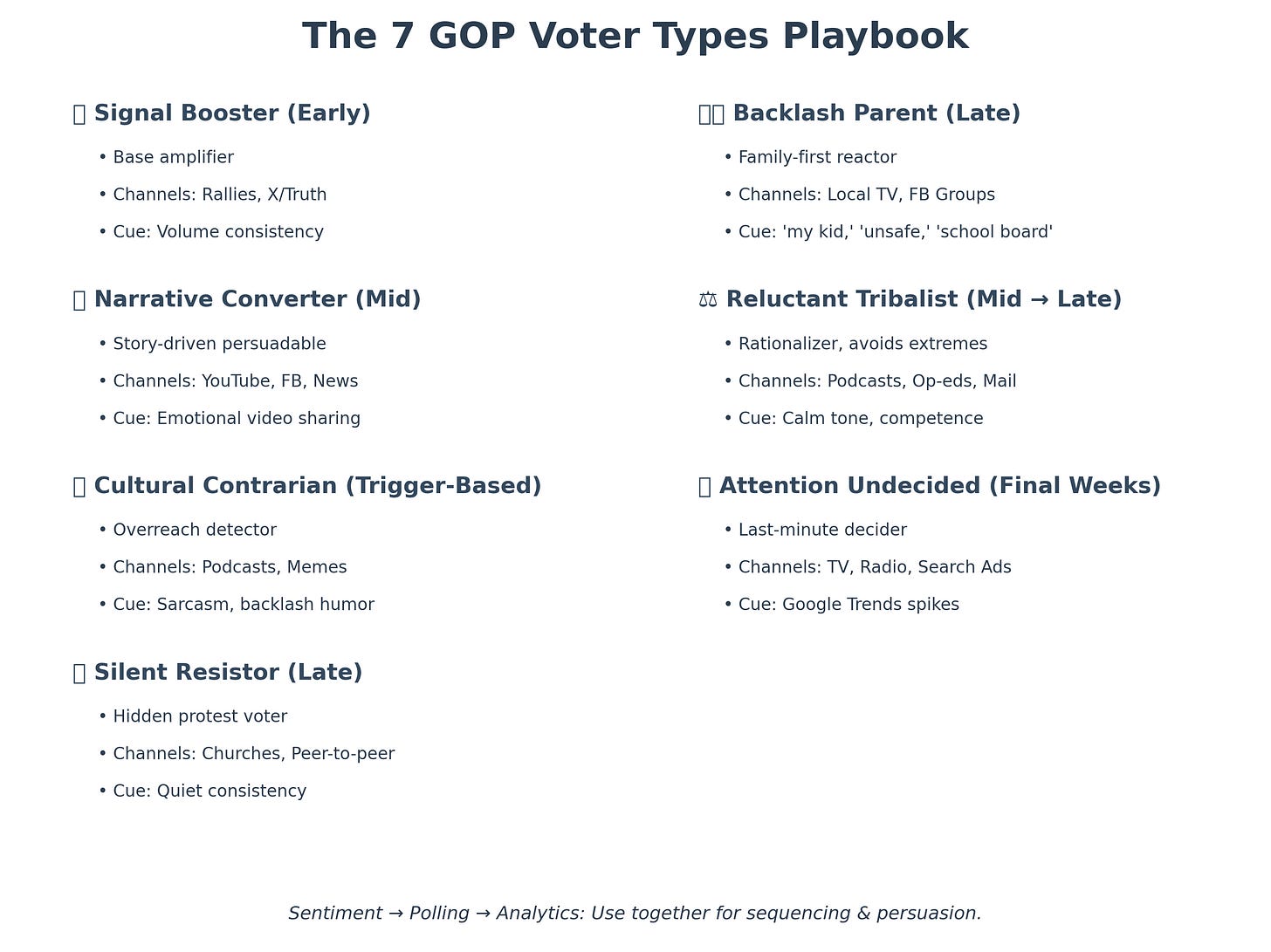Campaigns often think persuasion is about message discipline or ad spend.
But in reality, persuasion is about understanding who you’re talking to, when they’re listening, and how they respond emotionally.
Over the past five posts, we’ve built the framework:
The 7 GOP Voter Types
How to Persuade and Monitor Them
Sentiment as the Early Signal
The Messaging Calendar
Operationalizing Through the War Room
Now it’s time to put it all together.
This post is the field guide: a one-stop playbook campaigns can use to plan, execute, and adapt strategy around the 7 voter types.
The 7 GOP Voter Types (Field Guide Overview)
1. Signal Booster (📢)
Role: Base amplifier, message spreader
Timing: Early, always-on
Best Channels: Rallies, X/Truth Social, email
Sentiment Cue: Volume & consistency of amplification
Tactical Note: Keep them engaged, but don’t let their rhetoric box you in.
2. Narrative Converter (📰)
Role: Persuadable, shifts with the story
Timing: Mid-campaign, once narratives form
Best Channels: YouTube, Facebook, news clips
Sentiment Cue: Emotional video sharing, headline reframes
Tactical Note: Watch for narrative tipping points; time pivots accordingly.
3. Cultural Contrarian (🎭)
Role: Overreach detector, backlash mobilizer
Timing: Trigger-based (whenever elites push too far)
Best Channels: Podcasts, memes, Telegram
Sentiment Cue: Sarcasm, ridicule, counter-memes
Tactical Note: Let them police cultural excess; fuel the spark, don’t force it.
4. Silent Resistor (🤫)
Role: Hidden protest voter
Timing: Late, often final week
Best Channels: Church groups, local networks, peer-to-peer
Sentiment Cue: Consistency in quiet spaces, not volume online
Tactical Note: Don’t expect visibility—track proxies (attendance, keyword alignment).
5. Backlash Parent (👩👧)
Role: Family-first reactor (schools, safety, gender)
Timing: Late, triggered by local issues
Best Channels: Local TV, FB groups, neighborhood networks
Sentiment Cue: Keyword spikes: “my kid,” “school board,” “unsafe”
Tactical Note: Persuasion window is short—mobilize fast when the trigger comes.
6. Reluctant Tribalist (⚖️)
Role: Rationalizer, dislikes extremes
Timing: Mid → Late
Best Channels: Podcasts, op-eds, targeted mail
Sentiment Cue: Receptivity to competence, calm tone
Tactical Note: Avoid over-indexing on base rhetoric or you lose them.
7. Attention Undecided (⏳)
Role: Last-minute decider
Timing: Final 2–3 weeks
Best Channels: Broadcast TV, search ads, radio, mail
Sentiment Cue: Google Trends spikes around specific issues
Tactical Note: Ignore them early—save firepower for the final sprint.
How to Use the Playbook
Think of this as a layered strategy:
Sentiment tells you who’s moving right now.
Polling tells you how many are already there.
Analytics tells you where to find them.
Together, they let you run a war room that’s:
Proactive: Acting on sentiment before it calcifies.
Targeted: Directing resources to the voter types who are in play.
Sequenced: Messaging the right groups at the right time.
Final Takeaway
Campaigns that blast the same message to every voter, every week, are playing 20th-century politics.
Campaigns that sequence messages across voter types, guided by real-time sentiment, analytics, and polling, are playing to win.
This Playbook is the bridge between theory and execution.
Next Up (Part 7):
“Case Studies: How the 7 Types Decide Primaries in Real Time.”
We’ll look at recent races where sentiment shifts across these types flipped outcomes.


